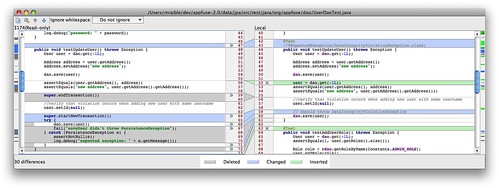Enhancing your GWT Application with the UrlRewriteFilter
Last week, I spent some time trying to change the location of my cache/nocache HTML files in my GWT project. I started the project with the gwt-maven-plugin's archetype. The message I posted to the gwt-maven Google Group is below.
Rather than having my application's HTML file in
src/main/java/com/mycompany/Application.html, I'd like to move it to
src/main/webapp/index.html. I tried copying the HTML and adding the
following to my index.html, but no dice:
<meta name="gwt:module" content="com.mycompany.Application"/>
Is this possible with the gwt-maven-plugin? I'd like to have my main
HTML and CSS at the root of my application.
The good news is I figured out a solution using the UrlRewriteFilter that 1) allows hosted mode to work as usual and 2) allows your app to be served up from the root URL (/ instead of /com.company.Module/Application.html). Here's the urlrewrite.xml that makes it all possible.
<?xml version="1.0" encoding="UTF-8"?>
<!DOCENGINE urlrewrite PUBLIC "-//tuckey.org//DTD UrlRewrite 3.0//EN"
"http://tuckey.org/res/dtds/urlrewrite3.0.dtd">
<urlrewrite>
<rule>
<from>^/$</from>
<to type="forward" last="true">/com.mycompany.app.Application/Application.html</to>
</rule>
<rule>
<from>/index.html</from>
<to type="forward" last="true">/com.mycompany.app.Application/Application.html</to>
</rule>
<-- This last rule is necessary for JS and CSS files -->
<rule>
<from>^/(.*)\.(.*)$</from>
<to type="forward">/com.mycompany.app.Application/$1.$2</to>
</rule>
</urlrewrite>
If you're using the gwt-maven plugin, this file goes in src/main/webapp/WEB-INF. In addition, you'll need to add the following to your web.xml.
<filter>
<filter-name>rewriteFilter</filter-name>
<filter-class>org.tuckey.web.filters.urlrewrite.UrlRewriteFilter</filter-class>
</filter>
<filter-mapping>
<filter-name>rewriteFilter</filter-name>
<url-pattern>/*</url-pattern>
</filter-mapping>
Finally, add the UrlRewriteFilter dependency in your pom.xml:
<dependency>
<groupId>org.tuckey</groupId>
<artifactId>urlrewritefilter</artifactId>
<version>3.1.0</version>
</dependency>
Please let me know if you have any questions.
Update: Jeff posted an alternative configuration that allows you to eliminate the last rule in urlrewrite.xml, as well as use the beloved mvn jetty:run command. To use cleaner WAR packaging and the Jetty plugin, add the following to your pom.xml:
<plugin>
<groupId>org.apache.maven.plugins</groupId>
<artifactId>maven-war-plugin</artifactId>
<configuration>
<webappDirectory>
${project.build.directory}/${project.build.finalName}/com.mycompany.app.Application
</webappDirectory>
</configuration>
</plugin>
<plugin>
<groupId>org.mortbay.jetty</groupId>
<artifactId>maven-jetty-plugin</artifactId>
<version>6.1.14</version>
<configuration>
<webAppConfig>
<contextPath>/</contextPath>
<baseResource implementation="org.mortbay.resource.ResourceCollection">
<resourcesAsCSV>
${basedir}/src/main/webapp,
${project.build.directory}/${project.build.finalName}/com.mycompany.app.Application
</resourcesAsCSV>
</baseResource>
</webAppConfig>
<scanIntervalSeconds>3</scanIntervalSeconds>
<scanTargets>
<scanTarget>${basedir}/src/main/resources</scanTarget>
<scanTarget>${basedir}/src/main/webapp/WEB-INF</scanTarget>
<scanTarget>
${project.build.directory}/${project.build.finalName}/com.mycompany.app.Application
</scanTarget>
</scanTargets>
</configuration>
</plugin>
Then you can trim your urlrewrite.xml down to:
<urlrewrite>
<rule>
<from>^/$</from>
<to type="forward" last="true">/Application.html</to>
</rule>
<rule>
<from>/index.html</from>
<to type="forward" last="true">/Application.html</to>
</rule>
</urlrewrite>
Of course, you could also change the welcome-file in your web.xml or use index.html and the <meta http-equiv="REFRESH"> option. Personally, I have so much affection for the UrlRewriteFilter that I like having it in my project. I'm sure I'll need it someday.
Thanks Jeff!









